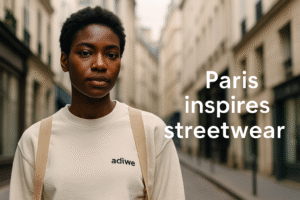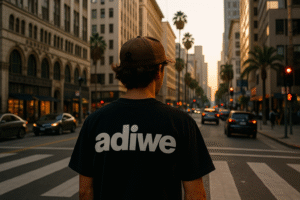Launching streetwear globally but confused by sizing? Wrong sizes mean returns, unhappy customers, and lost sales. Understanding market variations is key to international success.
Streetwear sizing varies significantly across markets due to different body an, measurement systems, and cultural fit preferences. North American sizes are often larger than Asian sizes, with European sizes falling somewhere in between or having their own unique standards.
Getting sizing right is a big deal. It’s more than just numbers on a label; it's about how your customer feels in your clothes. I’ve seen brands, full of excitement, launch in new countries only to face a wave of returns because the "Medium" in one place wasn't the "Medium" their customers expected. As a manufacturer in China, my company Adiwe works with clients like Fifty Fifty from England and brands across North America and France. So, we see these differences daily. It’s a challenge, but one that can be managed with the right knowledge. Let's look at why this matters so much.
Why is Understanding Regional Sizing So Crucial for Global Streetwear Brands?
Ignoring size differences seems small, but it's a big risk. This oversight can alienate entire markets, damaging your brand’s reputation and hurting your bottom line significantly.
Understanding regional sizing is vital because it directly impacts customer satisfaction, return rates, brand perception, and ultimately, profitability. Correct sizing builds trust and encourages repeat purchases in global markets.
!
When your streetwear doesn't fit as expected, customers get frustrated. This isn't just a minor inconvenience; it has real consequences. I remember a new brand from North America wanting to sell their oversized hoodies in Japan. They just used their US sizing. The feedback was quick: the hoodies were far too large, even for an "oversized" look. This led to costly returns and negative reviews. It’s not just about the financial hit from returns and wasted inventory. More importantly, it damages your brand's reputation. Customers who have a bad sizing experience are unlikely to buy from you again, and they might share their negative experience with others. In the B2B world, where we at Adiwe operate, providing accurate sizing for our wholesale clients – the trend brands and clothing lines – is essential for their success, and therefore ours. Our top quality promise extends to ensuring the fit is right, which is key for the very trendy products we create.
Key Impacts of Sizing Mismatches
Getting sizing wrong can have a ripple effect. It’s not just about one unhappy customer.
| Impact Area | Consequence of Poor Sizing | How Adiwe Helps Mitigate |
|---|---|---|
| Customer Trust | Erosion of confidence, perceived lack of professionalism | Provide detailed size charts, sample approvals |
| Return Rates | Increased logistical costs, unsellable returned stock | Guide on market-specific grading, quality control |
| Brand Image | Negative reviews, seen as unreliable or not understanding market | Offer personalized design including fit consultation |
| Market Penetration | Difficulty gaining traction in new regions | Share experience from exporting to NA, UK, FR |
Ultimately, good sizing shows you care about your customer and their experience. This is especially true for brands focusing on top quality and trendy designs. For clothing brands and KOLs we work with, a perfect fit is part of their brand identity.
What are the Key Sizing Differences Between North America and Asia?
Expanding to Asia or North America but unsure about sizes? A US "Large" is very different from an Asian "Large," leading to major fit issues and unhappy customers.
North American streetwear sizes (US/Canada) are generally larger and roomier than Asian sizes (e.g., China, Japan, Korea). Asian sizing often uses smaller increments and caters to a slimmer, shorter physique.

This is one of the most common sizing hurdles I see. Brands from North America often find their standard sizes are too big for Asian markets, while Asian brands expanding West might find their clothes too small. For instance, a Men's Medium t-shirt in the US might be equivalent to a Large or even Extra Large in Japan or Korea. At Adiwe, since we are a factory in China with 5 production lines, we are very familiar with Asian sizing standards. When we work with North American clients who want to produce streetwear like hoodies or t-shirts, we always discuss how their target end-consumer will perceive the fit. It’s not just about chest and length; it’s also about shoulder width, sleeve length, and overall silhouette. Asian streetwear sometimes favors more tailored or "neat" oversized fits, while American streetwear might lean towards truly voluminous styles. This understanding is crucial for our B2B wholesale business.
Comparing Key Measurement Points
Understanding specific measurement differences is key. These are general observations.
| Measurement | Typical North American Trend | Typical East Asian Trend (e.g., Japan, Korea, China) | Consideration for Brands |
|---|---|---|---|
| Chest Width | Generous, often "vanity sized" | Slimmer, more true to measurement | Define your desired fit per market |
| Body Length | Longer | Shorter | Factor in height differences |
| Sleeve Length | Longer | Shorter | Check against average arm lengths |
| Overall Fit | Looser, more relaxed (even for slim) | Often more fitted, even in oversized styles | "Oversized" means different things |
We often create detailed tech packs with specific measurements for each market if a client is targeting multiple regions. Our customizable fabrics and craftsmanship allow us to adjust patterns precisely for products like t-shirts and hoodies.
How Do European Streetwear Sizes Compare to US Standards?
Selling to Europe? US sizes don't always translate. European customers, like in the UK or France, have distinct fit expectations that can make or break your launch.
European streetwear sizes (e.g., UK, French) often fall between US and Asian sizes but can also be distinct. UK sizes might be closer to US, while French sizing can be smaller and more tailored.

Europe isn't one single market for sizing. There's a lot of variation. My client, Fifty Fifty from England, expects a certain fit for their hoodies that appeals to their young UK customer base. They focus on design and quality but also look for competitive prices, so getting the fit right the first time is important. Generally, UK sizes can be somewhat comparable to US sizes, perhaps one size down. However, French and Italian sizing, for example, tends to be significantly smaller and more "fitted" than US sizing. A French "Medium" is often much slimmer. As a factory exporting to England and France, main export countries for Adiwe, we have to be very precise. It’s not just about converting inches to centimeters. It's about understanding the desired silhouette. For example, a trendy oversized hoodie for the French market might still have a more shaped shoulder or a slightly less voluminous body than its US counterpart, even with personalized designs.
Navigating European Sizing Nuances
The key is research and knowing your specific target country within Europe.
| European Market | General Sizing Tendency vs. US | Key Considerations for Streetwear | Example from Adiwe's Experience |
|---|---|---|---|
| UK | Often 1 size smaller or similar | Similar body types, but preference for "neater" fits sometimes | Fifty Fifty's hoodies: specific grading for UK youth who like their brand |
| France | Generally smaller, more fitted | Emphasis on tailoring, even in casual wear | Designs may need significant re-grading from US patterns |
| Germany | Can be similar to US or slightly smaller | Value precision and clear sizing info | Clear, accurate size charts are vital for these clients |
| Scandinavia | Taller average, may need longer lengths | Fit can be minimalist and functional | Consider body and sleeve length adjustments for their market |
Understanding these differences is crucial for B2B clients like clothing brands who rely on us for accurate production. Top quality also means a top-quality fit, which is why our customizable fabrics and craftsmanship are so important.
What Practical Steps Can Brands Take to Navigate Global Sizing Effectively?
Global sizing feels complex, risking costly errors. But what if simple steps could ensure your streetwear fits customers perfectly, everywhere you sell, boosting satisfaction?
Brands can navigate global sizing by creating detailed, market-specific size charts, gathering local fit feedback, offering clear conversion guides, and working closely with experienced manufacturers who understand international sizing.

Successfully managing international streetwear sizing isn't about guesswork; it's about a clear strategy. The first step I always recommend is thorough research. Don't just assume. Create detailed specification sheets (tech packs) for every garment, with clear measurements for each size you plan to offer. These shouldn't be generic. If you're selling a hoodie in both the US and Japan, you might need two different sets of graded measurements for what you call "Small," "Medium," and "Large." At Adiwe, we encourage our clients to provide this, or we help them develop it. Getting samples made and tested by people in your target market is invaluable. For our B2B clients, like KOLs or trend brands, ensuring their customers get a good fit is paramount to their brand's image and sales. This is a key point for sourcing, similar to quality control and logistics.
Actionable Sizing Strategies
Here are concrete actions to improve your global sizing approach:
| Strategy | Description | Benefit for Your Brand | How Adiwe Supports This |
|---|---|---|---|
| Market-Specific Size Charts | Create unique charts for each region (e.g., US, EU-UK, EU-FR, Asia). | Reduces confusion, improves fit accuracy. | Can advise on regional norms based on export experience. |
| Local Fit Models/Feedback | Test samples on people from your target demographic in each market. | Provides real-world fit validation. | Produces samples to exact specs for testing. |
| Clear Product Descriptions | Note if an item runs small/large, or its intended fit (e.g., "oversized"). | Manages customer expectations. | Can advise on typical fit descriptions. |
| Work with Experts | Partner with manufacturers experienced in international sizing. | Leverages their knowledge and reduces errors. | We have 5 production lines and export globally. |
My client Fifty Fifty often sends detailed feedback on samples for their complex hoodie designs, a pain point for them as many manufacturers struggle with full reproduction. This kind of collaboration is key. Our ability to offer personalized design and customizable fabrics, craftsmanship, logos, and accessories also means we can adapt to these specific sizing needs effectively.
Conclusion
Global streetwear sizing is complex, but manageable. Research, clear communication, and expert partners like Adiwe ensure your designs fit well worldwide, keeping customers happy and your brand strong.




